Abstract
This paper presents a robotized small tractor designed to perform humanitarian demining operations and agricultural operations when demining is accomplished. This dual use makes this system unique. The focus is on the design of the machine, including the modeling for design and control, the characteristics of the tools operated by the machine, the motion control at tele-operated, and semi-autonomous levels. The mechatronic design process applied uses sustainable design strategies. Technical contributions are in the tractor architecture, designed to make automation easier, and in the control functions implemented on this architecture. Extensive field tests were performed in different sites; first, in Italy, focusing on the agricultural application of the machine, in natural scenarios with different ground and vegetation; then, in two real mine fields in Jordan focusing on the performance for technical survey in humanitarian demining. The tests have confirmed the performance for both task categories (agricultural and demining), confirming the correctness of the statement. For the demining application, the machine has been assessed by professional users confirming the acceptance to field use and the novelty of the concept.
1. Introduction
Agriculture involves different kinds of tasks, from accurate transplanting and meticulous individual plant curing [1] to heavy ground processing work. In the past, in more developed countries, and today in developing countries, agricultural mechanization through tractors contributed to improve the effectiveness and productivity of the field heavy works. Most existing agricultural tractors still need extensive human operation: a next step is transferring the results of tractor robotization to the fields ([2,3,4,5,6], together with many other works). As confirmed by current trends, today, in both developed and developing countries, the availability of human resources for farming is decreasing due to labor shortage both for lack of interest from young people and for weak or aging farming workforce: this means that each worker, sometimes weak, is responsible for larger extensions of land. These factors influence the development of local agriculture and open a market share for automation also of small machines (mass lower than three tons). Differently from heavy tractors, small machines with competitive cost cannot be effectively developed simply modifying existing manual driven models: their architecture should be rethink for automation. The paper presents the case of a small tractor called LOCOSTRA. A peculiarity of this machine is that it performs very well tasks related to agriculture and to humanitarian demining using same implements.
LOCOSTRA costs like an agricultural system, four times less than the cheapest machine for demining; furthermore, after demining, it can be used on the same land demined, operated by local people, in part already trained while participating to demining [7]. This contributes more than any other means or method to the development and mechanization of agriculture in areas that have been generally strongly hit by war events [8,9]. Moreover, these areas may benefit of foreign funding for demining that they would never have for agricultural development: today the funding for demining is used to pay huge machines, running tools not useful for agriculture, expensive to operate due to fuel and maintenance costs, that become useless at the end of the demining.
LOCOSTRA is designed to satisfy end-user requirements and sustainability paradigms [10]. Figure 1 shows a strategy wheel with the principles that qualitatively characterize the design of LOCOSTRA (stars) in comparison to a traditional ground processing machine (squares). The six characteristics considered are relevant for both agriculture and demining. They oriented the design effort and were used to improve step by step the solution. The plot of the strategy wheel of a new design was compared to the plot of the initial design, considering which strategies were effective, which were not so effective, and trying to assess where more improvements could be made in the following design iteration.
These six characteristics regard: the use of materials with respect to the functions, human friendly life cycle, ecological impact, extended services and functions, revalorization, health, and environment risk.
On the use of materials, the two peculiar characteristic of LOCOSTRA are the power to mass ratio, higher than the average of agricultural tractors, and the mass (between 2.5 and 3.5 metric tons, depending on the implement), much lower than the one of machinery for similar demining tasks (smart minimalist armoring and no one on board). For both characteristics, LOCOSTRA is an example of break innovation originating from a critical analysis of the requirements face to the task, in opposition to following a common practice.
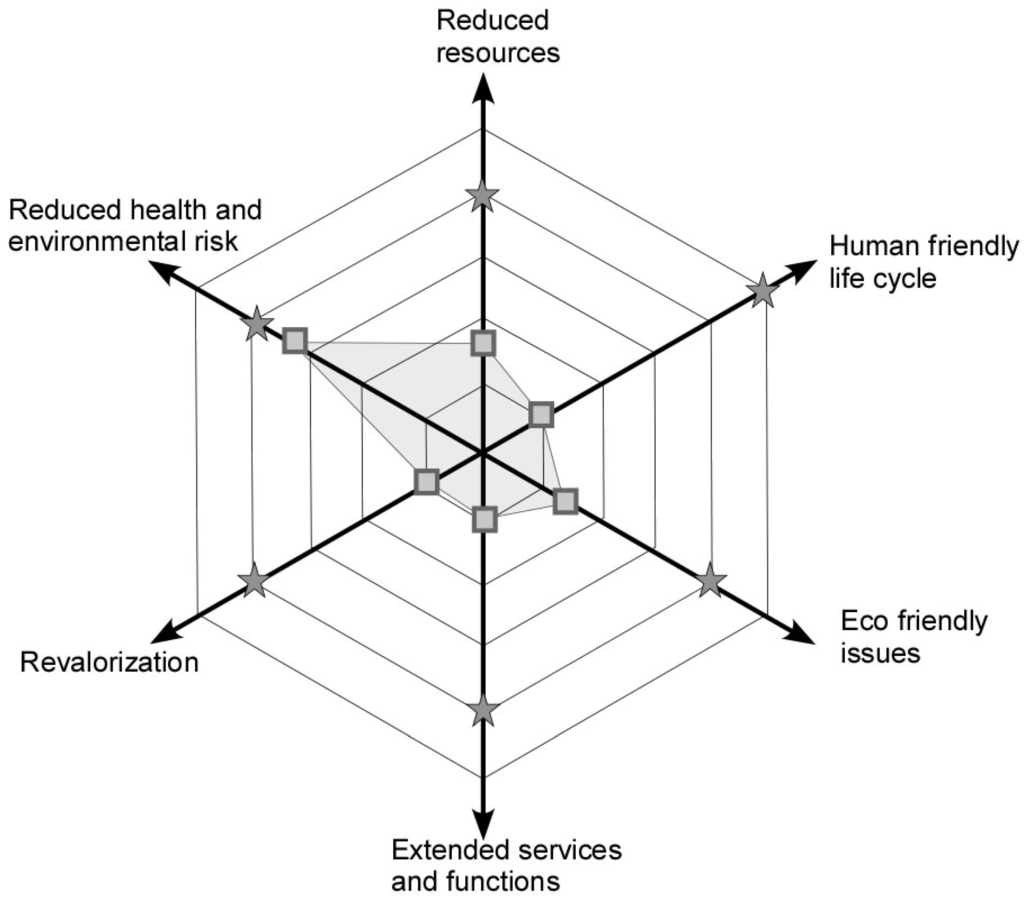
Figure 1.
Eco-design strategy wheel.
The machine design is user-and task-oriented: the user needs have been collected in questionnaires and normalized with respect to the local environment; the user interface is intuitive, and maintenance and repair operations can be done locally using available skills.
The ecological impact is low, either due to the use of Western standard powering, although the machine does not operate under strict regulation on emissions, and for the high efficiency of the engine and driveline. It is lighter than others with respect to its tasks, and stays in place for agriculture after demining.
The dual use (agriculture and demining) makes the machine immediately compliant to the point on extended services and functions [11]. Furthermore, the machine is small but can run implements with high power demand normally operated by tractors in the higher size class, so the same machine can perform over a wider range of activities. This is an advantage in a context of developing agricultural automation, where few machines are available for all tasks; the Western market of technologically advanced tractors does not satisfy this niche demand.
The design and realization of the machine can be pursued in a craft way, making easy the disassembly operations that allow, at the end of life, the recovery and re-use of components giving revalorization to the investment.
Certainly, the machine reduces health risk and hard work to humans in both agricultural and demining tasks. The reclaim, to agriculture, of mined land has a double social advantage [12].
The automation of an already existing agricultural tractor rather then designing a whole new robot for use in agriculture and demining has many advantages [13]. The battery of the tractor and the diesel engine supply all the electronic elements, included in the control system, thus, removing the problem of batteries and autonomy. The overall design can withstand harsh atmospheric conditions, the machine can traverse rough terrains, has working-day autonomy and is efficient in its tasks. Additionally the problem of heavy payloads, of significant limitation for small robots, has little or no significance. In addition, the cost of the robotization of an agricultural tractor is a relatively small percentage of the tractor cost.
The paper is organized as follows. Section 2 is dedicated to the LOCOSTRA functional design from the mechanical point of view. The foundation of the kineto-dynamic model used for the knowledge based definition of the LOCOSTRA parameters and control functions is presented. The design and implementation of the most innovative modules are the subject of the second sub-section. The motion control is illustrated into the third section in both the remote control level and the autonomy enhanced module. Section 4 reports on the experimental tests made in the field, in Italy, mainly aimed to check the agricultural operational performances of LOCOSTRA. Then the tests performed in two mine fields in Jordan are described.
2. Mechanical Architecture and Design
LOCOSTRA is a small, lightweight, four-wheel driving (4WD), electro hydraulic driven, articulated steering (AS) mini tractor. Different from agricultural automated tractors, that is based on human driven machines with sensors and actuators added to replace the driver, LOCOSTRA has been designed as a robotic vehicle with suitable architectures of the driveline and the control. A human can sit onboard and drive it, but with an additional interface that operates on the robotized layer.
LOCOSTRA can work on agricultural fields and AP mine-fields. These environments are similar, distinguished by the possible occurrence of AP mine blasts: the chassis design developed makes the vehicle insensible to mine fragments; blast resistant wheels protect the machine from blast shocks. Shaped mild steel deflection plates, 3 mm thick, cover the extremities of the axles and stop and deflect fragments projected by the agricultural implement or due to blasts.
The machine is designed to be easily transported over unimproved terrain without the need for a dedicated transporter. When medium to short distances have to be covered, the tractor can be equipped with traditional pneumatic wheels. The maximum travel speed is 30 km/h. A summary of possible tools and configurations of LOCOSTRA is shown in Figure 2.
2.1. Platform Driveline and Architecture
Almost all agricultural tractors use a mechanical driveline with the engine connected to a gear box and shafts transmitting motion to the axles; the drive involves the control of clutch and gear box; the torque at the wheels changes with the speed and can be controlled in a range with an engine load command.
Small construction machinery uses hydrostatic transmissions with the engine driving a pump and the pump feeding hydraulic motors; the motors, of which there are usually two or four, drive single wheels or an axle.
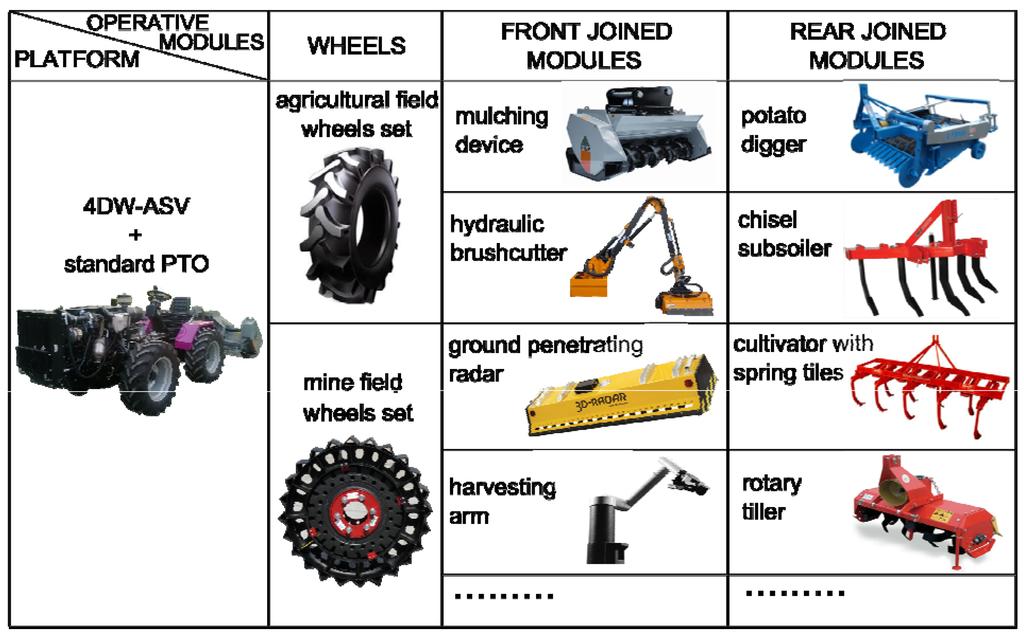
Figure 2.
Modular view of LOCOSTRA.
The LOCOSTRA driveline, shown in Figure 3, is a compromise between these two common architectures above: one pump driving one hydraulic motor, which drives mechanical transmissions to the axles; the power-take-off shafts (PTO; two, at the rear and front of the vehicle) are independently driven by the engine, with electro-hydraulic clutches. This simplifies, remarkably, the operation of the machine; the torque at the axles can be constant for any speed of the tractor and continuous variation of the speed is available from zero to maximum; on the other hand, the driveline efficiency remains high and close to the one of fully mechanical drivelines.
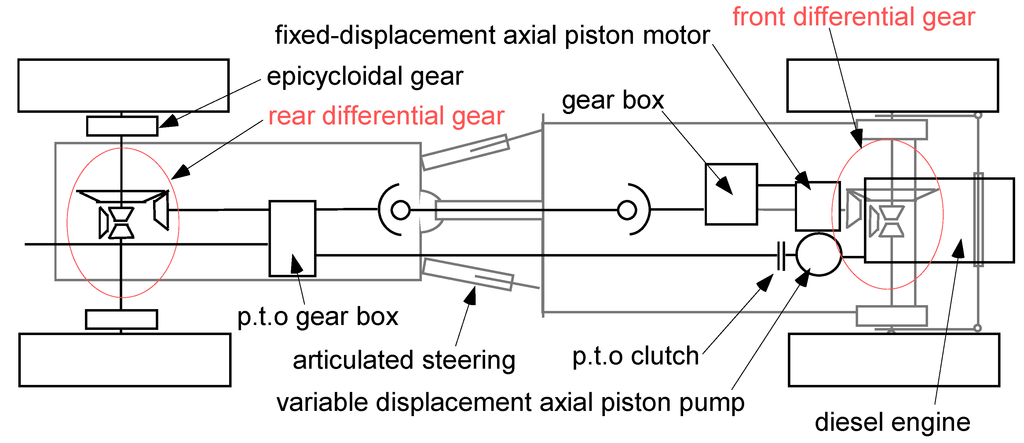
Figure 3.
LOCOSTRA platform scheme.
Another innovation is in the kinematic architecture of the articulation joint, which uses a spherical joint and a link with a contact pair to constrain pitch rotation of the front with respect to the rear of the tractor. This gives a higher resistance to impulsive loads generated by under-wheel blasts.
Two steering methods are available: front wheel steering and articulated steering. The two methods are combined by the control system to minimize the difference of average speed between the front and rear axles while the tractor is turning; thus, there is no need for a central differential gear and the driveline is more compact and simple: driving resistance forces are lower and tire wear is reduced.
A standard three point linkage attachment at the rear, interfacing implements in both agricultural class 1 and 2 standards, can lift and drive implements with mass up to half the mass of the tractor (and 1.5 m backward offset of the center of mass with respect to the rear axle) with the potential to operate dedicated robotic devices for agricultural or demining tasks (more complex than common agricultural implements) [14], see Figure 2.
Despite the above-mentioned advantages, the articulated frame steering layout introduces some problems to AS vehicles, including roll and lateral instabilities in different situations. As the tractor is used for both demining and agriculture and it is particularly meant for steep lands and very irregular terrain, the waving lateral motion is relevant. In addition, the control system could improve, in real time, the vehicle stability, a smart choice of the parameters aimed to improve lateral vehicle stability (especially while using the central steering) was considered at the vehicle design level. The lateral stability of the articulated vehicle was analyzed by simulating the dynamic behavior, based on the non-linear model, hereafter summarized.
A simple but realistic non-linear 3-DOF model was used to dimension the vehicle with intrinsic yaw stability. The model is illustrated in Figure 4 where the X−Y reference frame is the global coordinate system fixed to the ground.
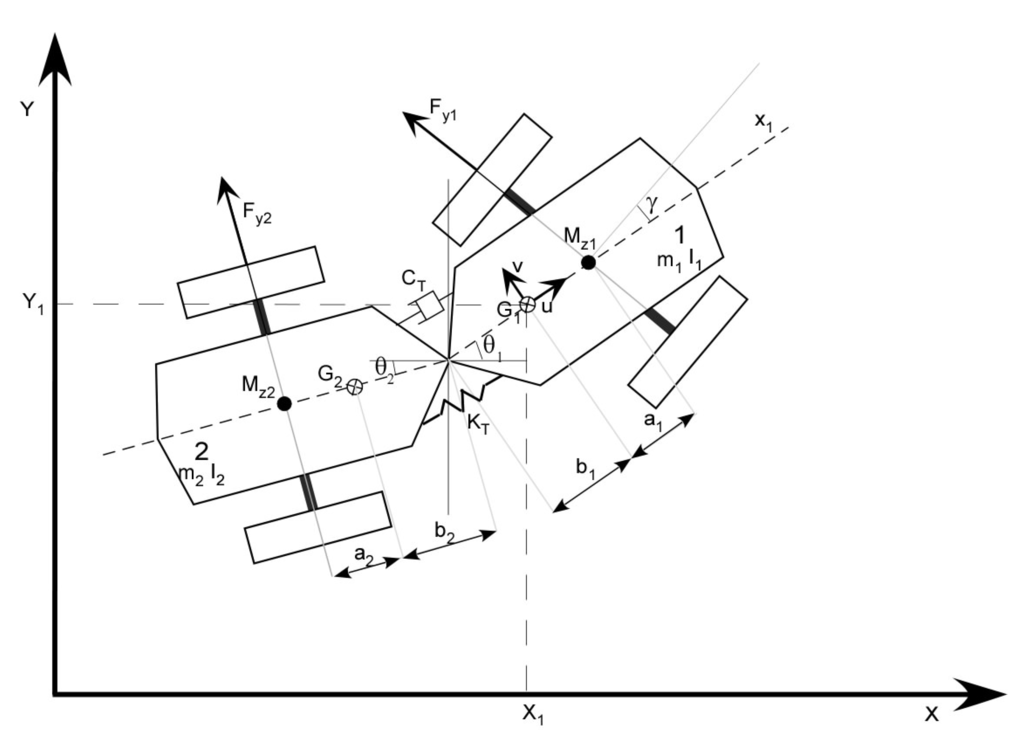
Figure 4.
LOCOSTRA kinematic scheme, yaw plane.
If it is assumed that the front part of the vehicle is not affected by the changes in the articulation angle, the only secondary motion is the yawing motion of the rear part. In addition, it is assumed that the tire rolling resistance is very small and, thus, it is neglected. Moreover, the aerodynamic resistance is neglected due to the low speed. In addition, it is assumed that the vehicle is travelling on a soil surface with constant tire-road contact parameters and the forward speed is assumed constant. The gyroscopic effects are neglected and the axles and wheels are assumed lumped in with their respective parts.
Following the work of Horton and Crolla [15], a torsional spring KT and a torsional damper CT at the articulation joint were considered to represent the hydraulic cylinders between the front and rear portions of the tractor.
For this model, θ1 is the yaw angle between the front part centerline and the X axis. In addition, θ2 is the angle between the rear part centerline and the X axis.
The model refers to the state vector [X1, Y1, ϑ1, ϑ2] where the chosen state variables are the absolute coordinates of the front part center of mass X1, Y1 and the front and rear body yaw angles ϑ1, ϑ2. The velocity of the rear part center of mass is:
 where b1 and b2 are the distances from the articulated joint to respectively the centers of mass of the front and rear portions of the tractor.
where b1 and b2 are the distances from the articulated joint to respectively the centers of mass of the front and rear portions of the tractor.

The motion model is derived using the Lagrangian approach.
The kinetic energy T of the platform is obtained by summing the kinetic energy of the front and rear parts, respectively T1 and T2:
 where mi and Ii represent the front (i = 1) part mass and moment of inertia, respectively. The same parameters for the rear part are described by i = 2.
where mi and Ii represent the front (i = 1) part mass and moment of inertia, respectively. The same parameters for the rear part are described by i = 2.

The potential energy U of the system is due to the torsional spring at the articulation joint:
 Where KT is the equivalent torsional stiffness of the hydraulic cylinders, modeled as linear springs including joint mechanical compliance and flexibility of the hoses.
Where KT is the equivalent torsional stiffness of the hydraulic cylinders, modeled as linear springs including joint mechanical compliance and flexibility of the hoses.

The dissipation energy R is modeled as in Equation (4) where the equivalent torsional damping CT includes, beyond the joint torsional damping, the effects of friction, and leakage.


The generalized external forces are obtained by introducing the position Equation Y2 = Y1 − b1 sin ϑ1 − b2 sin ϑ2 into Equation (5), and collecting the terms in δY1, δϑ1 and δϑ2; they result in:


The off road tire model based on the mobility number was used [16]. The mobility number was first defined by using dimensional analysis to model the tire forces; it models the effects of the tire size, load, and soil conditions [17]. Due to the modularity of the approach and of the model implementation in Simulink, other tire models can be adopted. The one used considers a modified definition of slip s’ and computes the tire longitudinal force Fx in function of the vertical load on the axle Fz as:
 where ω is the wheel angular velocity, R is the tire effective rolling radius; Cs and k1 are constants depending on the tyre and on soil hardness [18]. The values used in the design of the vehicle are for compact hard soil (0.67 and 0.16, respectively); this is also correct for blast resistant wheels with the design we used (inner rubber core and outer steel envelope).
where ω is the wheel angular velocity, R is the tire effective rolling radius; Cs and k1 are constants depending on the tyre and on soil hardness [18]. The values used in the design of the vehicle are for compact hard soil (0.67 and 0.16, respectively); this is also correct for blast resistant wheels with the design we used (inner rubber core and outer steel envelope).

Called α the slip angle [19], the lateral side force can be computed analogously:
 with Cα and k2, respectively, 0.67 and 0.21.
with Cα and k2, respectively, 0.67 and 0.21.

The tire self alignment moments are computed with analogous equations.
The model of the lateral motion is derived as three second order non-linear equations in the independent variables q1 = Y1, q5 = θ1 and q3 = θ2, applying the Lagrange approach:
 where all the energy components are computed using Equations (1–8).
where all the energy components are computed using Equations (1–8).

The model was symbolically solved using Maple and then written in Simulink modules. The simulation results of the adopted non-linear model in the case of small angles were compared with the results obtained by Lashgarian Azad [19] using a linearized model for validation purposes.
From the simulation tests, for a given set of realistic parameters, it could be observed an undamped oscillatory yaw motion or unstable snaking mode over a speed value. As the forward speed u increases, the amplitude of the unstable snaking mode grows at a higher rate. If KT increases, the stability of the vehicle oscillatory yaw motion improves; if the torsional damping CT at the articulation joint increases, the vehicle will be stable up to a given speed. These results are in accordance with the ones for similar AS vehicles, discussed and reported in the literature. They have been used to select the design parameters of the hydraulic rams actuating the articulation of the tractor. In the final design, we use two plunger type hydraulic cylinders with half-inch hoses and flow control valves. The flow control valves have been tuned experimentally to damp yaw oscillations in the speed range of the machine. The design parameters of the whole machine are summarized in Table 1.

Table 1.
LOCOSTRA main data.
| Length | 3.5 m | Max mass of implement | 900 kg |
| Width | 1.45 m | Armor thickness (steel plates) | 5 mm |
| Normal clearing/working width | 1.50 m | Max engine power at flywheel | 55 kW |
| Front to rear axle distance | 1.50 m | Max engine power at working tool | 48 kW |
| Inner distance between wheels on same axle | 0.95 m | Fuel capacity | 50 lt |
| Height (overall) | 2.3 m | Oil capacity | 12 lt |
| Mass (basic) | 3,100 kg | Cooling system | Water |
2.2. Implements
The work has focused on a set of typical, almost purely mechanical, agricultural implements and on two complex implements driven by PTO shaft. All implements have been tested in the agricultural design and in a modified version dedicated to technical survey in humanitarian demining. The application in humanitarian demining is in the phase called technical survey, part of the land release process: the machine explores land where landmines might be present; the scope of the exploration is finding evidence of mines on portions only of this larger initial area. Typical operations involved are vegetation cutting, land breaking, mine sweeping. The tractor may accidentally run over a mine that may explode under the wheel, so special wheels are required resisting the blast and damping the energy transmitted to the axle and chassis.
2.2.1. Standard Wheels
Wheel characteristics affect both the performance of the tractor in terms of maximum drawbar pull and tractor manoeuvrability.
The wheel diameter of LOCOSTRA was decided as a compromise between manoeuvrability (the smaller wheel radius, the smaller minimum radius of curvature) and drawbar pull (the higher wheel diameter, the higher adherence but higher torque required).
For the radius of curvature, a simplified model of the machine was used with all degrees of freedom modeled with their spans.
The wheel diameter with respect to drawbar pull Dp has been computed with the following equations in terms of the wheel diameter D [m] and width b [m], engine output torque Te [Nm], overall transmission efficiency ƞ reduction ratio τ, and vehicle body mass m:


The equation to calculate the rolling resistance Fi of the wheel for rigid wheels over unprepared terrain is derived empirically by Bekker [20], who introduced the pressure sinkage parameter n typical of the interaction ground-wheel. The n parameter value was chosen from the table of data collected by Bekker for different types of soil. In particular in our case n = 0.5, Te = 230 Nm, τ = 49, ƞ = 0.95, b = 0.244, m = 2,450 kg.
The compromise wheel diameter selected is 950 mm. The steering radius is 2,370 mm with articulation, and 1,800 mm with articulation and front wheels steering.
2.2.2. AP Mine Resistant Wheels
The wheels mounted on the tractor during demining related operations are designed to withstand the detonation of 240 g of TNT and to resist at least five explosions before some maintenance may be required. The wheels must keep the tractor safe by reducing the shockwave transmitted to the hub to harmless levels; they have to be inexpensive and easy to repair locally, to allow efficient traction and to be lightweight. The same wheels are mounted on the front and rear axles.
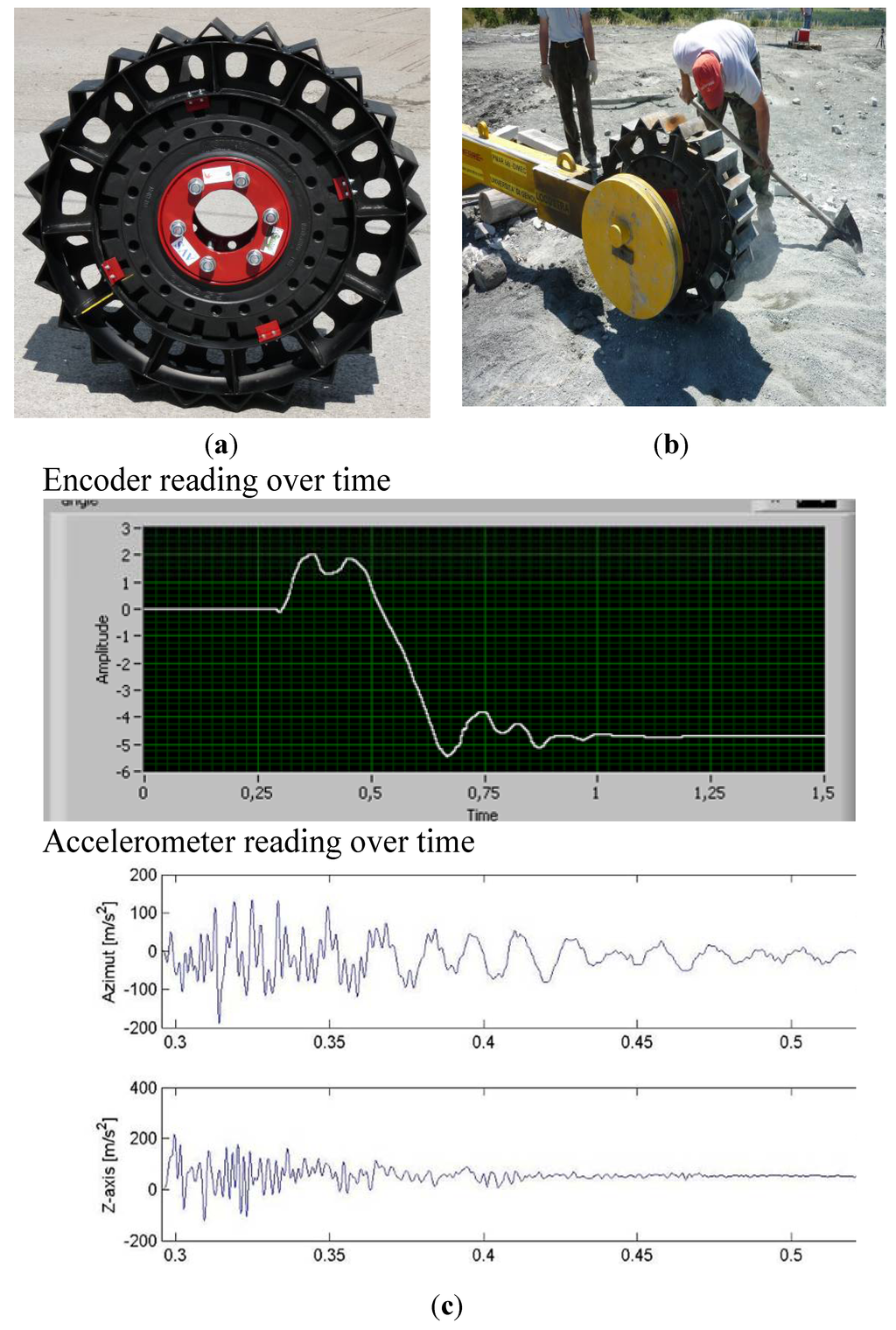
Figure 5.
Wheel tests with ballistic pendulum (a,b) and example accelerometer acquisition for a 240 g TNT blast (c).
The wheel architecture adopted comprises a solid rubber tire embedded in an outer steel envelope providing ventilation of the blast gas and protection of the inner tire. The inner tire dampens the blast shock-waves. Four different wheel designs with the same outer diameter were manufactured and tested with explosions on a ballistic pendulum and on the tractor in real conditions [21,22], Figure 5. The wheel selected was further modified to simplify the design of the steel envelope.
2.2.3. Vegetation Cutting Implements
The mulcher is the main tool used to clean vegetation over an area before technical survey and any other demining operation can start. The same tool is commonly used in agriculture, as an alternative to cutter bars, to cut the vegetation over land before the ground is processed. Different cutting principles are used. Two implements to cut the vegetation have been developed, one using the principle of the mulcher, the second one using cutter bars.
The mulcher implement is based on a modified commercial mulcher. The modifications comprise the adaptation of the enclosure and frame to withstand possible explosions and the implementation of two depth sensors at the sides, with oscillating bars, to control the height of the tool with respect to the average ground level. When the mulcher is operated, the control system of the tractor switches automatically to speed-control mode. The speed of the machine is controlled to maintain constant power of the engine: the power required by the mulcher to run at constant speed while processing is very sensible to the velocity of advancement in the vegetation as the quantity of vegetation processed in the unit of time depends on this velocity.
The implement using cutter bars uses three bars, one horizontal and two vertical at the sides: the horizontal bar cuts the stems while the vertical bars cut branches to open a corridor. Compared to the mulcher, this tool leaves the material cut on the ground.
2.2.4. Side-Arm Brushcutter
The side-arm brushcutter developed is based on a commercial agricultural arm boom actuated by hydraulic cylinders operated by a hydraulic flow divider and simple on-off electro-hydraulic valves.
Angular sensors have been added to measure the current arm configuration; a pressure sensor enables the control of the arm in floating mode during cutting. The original hydraulic was replaced with solenoid operated proportional control valves that allows smooth and accurate control of the arm motion and make trajectory generation of the bush-cutting tool easier. The valves are directly operated by PWM signals generated by the electronics.
2.2.5. Ground Processing
The ground processing tool developed is based on a modified potato digger. This tool can be used as a higher performance potato digger for agricultural tasks, as well as to expose mines in the soil. Compared to in use sifter implements, carried by 20-ton class dozers, the potato digger can be used over lands with any local surface geometry guaranteeing the desired work depth.
The agricultural potato digger was reinforced in a way to lower the level of damages resulted by the mine explosions and to prevent fragmentation of the damaged parts. This tool is equipped in with a sensor measuring the working depth. The control system having the information of the working depth of the tool is adjusting by commanding the tractor three-point linkage lift to ensure it is proper for the ongoing activity (digging potatoes or digging mines). In demining activities, it is very important to assure the proper digging depth, as it is required for further operations taking place in the processed areas. An additional feature specifically intended for the demining is a metal detector bar mounted on the rear part of the potato digger. The metal detector passes signals of detected metal objects (possibly mines) to the control system. In the future, having already installed DGPS positioning system, the control system will pass information about the detected objects and its position to the higher level management system (implemented in the ROS environment) in order to build a map with the suspected mine positions.
3. Control System
3.1. Overview
A master-slave architecture is used with the tractor as slave; master can be the implement, in the case of complex implements, which have a dedicated control and that can command the operation of the tractor based on their task requirements; master can also be a supervising layer, for example, planning agricultural or demining operations over an area.
The control system is distributed: the control hardware resident in the tractor and the control algorithms there implemented manage all tractor onboard functions and make available the higher level functions of: trajectory following, speed control, steering control, power control, PTO shaft control, three point linkage lift control, and control of the oil distributors. The tractor can operate at constant speed, constant power, constant pull-bar force.
The control variables are: engine velocity, engine torque, engine working modes, engine fan air draught direction, pull-bar force, three point linkage lift level, hydraulic motor, and pump displacement.
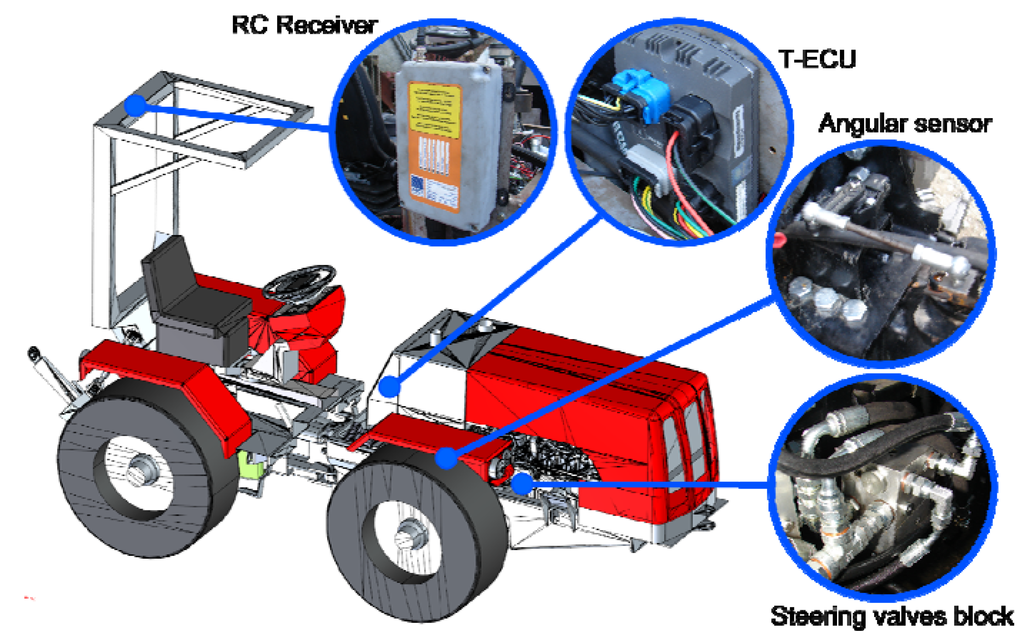
Figure 6.
Control system elements (core components).
The hardware components of the control are shown in Figure 6; a schematic is provided in Figure 7 [23]. An EPEC 2024 module is used as main control board as it is widely applied in mining, agricultural, forest, and construction machines. It comprises 52 I/O pins (Digital, Analog, PWM) and two CAN ports. The main board is connected to a set of devices: (1) powertrain control devices (via CAN-BUS, J1939 protocol); (2) actuators (via I/O pins); (3) sensors (via I/O pins); (4) human machine interface (HMI) devices (via CAN-BUS, J1939/CANopen/ISObus-ISO11783 protocols); and (5) auxiliary devices (via I/O pins and CAN-BUS using J1939/CANopen/ ISObus-ISO11783 protocols). The basic operation of the tractor (ignition, steering, adjusting velocity, switch between steering axis—front wheels and central articulation) is carried out by controlling electro-hydraulic solenoid valves (PWM or ON/OFF signals for proportional and open/closed valves, respectively), which operate the onboard actuators. The control of the engine is provided by a powertrain control module (PCM) interfaced to the T-ECU over the CAN-BUS (J1939 protocol). The PCM provides to the T-ECU a vast set of information used to manage the operation of the tractor (in particular: engine oil pressure, malfunction alarms, engine speed, engine load at current speed); the T-ECU can set parameters in the PCM to adapt the engine operation to the current tractor operation (desired speed/speed limit, desired torque/torque limit, and others).
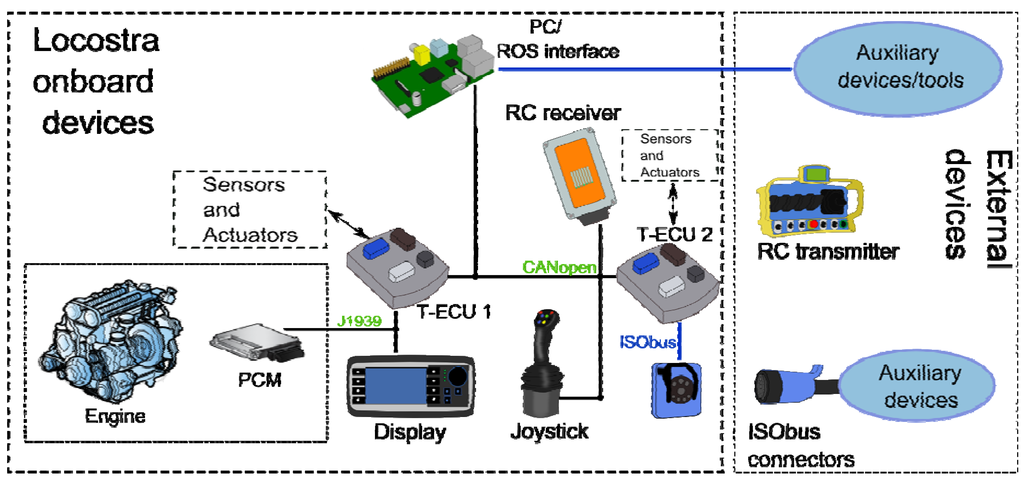
Figure 7.
Diagram of the tractor electronic control system (TECS).
Having implemented the ISObus protocol in the control system it is possible to profit from the use plug and use type implements (ISObus ready). The agricultural implements with ISObus interface can directly command some of the tractors’ parameters, such as: requested velocity, use of PTO shaft, use of oil distributors, three point linkage lift level, engine working mode; and present its own working parameters on the tractor’s display. In a second direction, with ISObus interface, some of the implement’s functions can be commanded using tractor’s onboard controllers, e.g., no additional controller is necessary to work with the side-arm brushcutter, it can be commanded using the joystick onboard of the tractor.
At the logical level, ROS middleware is used because it supports well the modular and scalable control architecture adopted. In order to profit from the use of ROS environment we have introduced a module (PC) running ROS middleware. This module provides a tractor higher-level communication interface in a form of services for all the robotized tools and other units cooperating with the tractor (other ROS nodes in the network). It will make easier having one or more tractors part of a multirobot system, and implement and apply algorithms developing its autonomy.
This ROS module providing all the tractor control functions (steering, power control, implement control, etc.) and operational data (tractor’s position, velocity, etc.) makes the tractor fully controllable by the master units – robotized tools which need to control the tractor behavior in order to proceed with their work. An example of such a master unit is a 5DOF manipulator with a metal detector or other kind of sensor or actuator controlling the tractor’s movements and actuators in order to perform planned actions (e.g., autonomously checks a selected area in a field for mine presence or dig holes and plant trees in specified positions).
3.2. Control Modes and Human Machine Interface
The tractor is equipped with three human machine interface devices that operate on the slave control level. Three control modes are available: human onboard, human remote, and ISObus.
In the human onboard mode, the driver uses an onboard joystick, a conventional steering wheel, a 4.3″ industrial display and pedals with electric signal transduction. The display (Wachendorff OPUS A3S) provides information about the state of the tractor (e.g., velocity, engine speed, coolant temperature), it visualizes alarms and warnings (e.g., low fuel level, low oil pressure, sensors malfunctions) and allows to input data and changes T-ECU settings (e.g., engine work parameters, tractor operational parameters). With the onboard joystick, the operator can control the velocity of the tractor, the actuators controlling the position of the implement, the blockage of the differential gears of the axles, the rear power take-off (PTO) shaft, and operate singularly the steering axes.
In the human remote mode, the driver uses an industrial remote control (RC) system connected and interfaced to the TECS. The RC system is composed of two units: receiver and transmitter. The receiver is mounted on-board and is connected to the internal tractor CAN bus (CANopen protocol) providing a bi-directional communication between T-ECU and the RC transmitting unit. It also ensures a high level of safety during the work introducing to the system a safety circuit having a Pl:e (Performance level) category 4 and/or SIL 3 (Safety Integrity Level) according to the standards ISO 13489-1 and ISO 62061, respectively. The transmitter, Figure 8, gives the operator control over a majority of tractor functions and visualizes a feedback information from the T-ECU. It allows control of the tractor velocity, the range of speed, the steering, the differential gear blockage, the front and rear oil distributors, the three-point linkage lift, the PTO shaft. In normal operation, front wheel, and articulated steering are automatically combined: the operator can choose to take the control of each of the two independently. Furthermore, the transmitter allows to control the tools (implements) attached to the tractor (side-arm brushcutter as default) using a set of four unidirectional proportional joysticks. The LED indicators and the display mounted on the transmitter provide feedback information from the T-ECU (e.g., active steering switching mode, engine parameters, working parameters, warnings, and alarms).
The most advanced control mode is an autonomous control mode. In this mode the tractor performs specific actions under a control of higher level implemented using the ROS framework, or it works as a slave machine, controlled by the intelligent implements attached to the tractor. The units controlling the tractor can command velocity, driving direction, engine working mode and speed, oil distributors, three-point linkage lift, and PTO shaft.
In the next step of the development the LOCOSTRA tractor will be equipped with a RTK DGPS positioning system in order to implement the localization and navigation systems and make it able to perform fully autonomous tasks in the field [24].
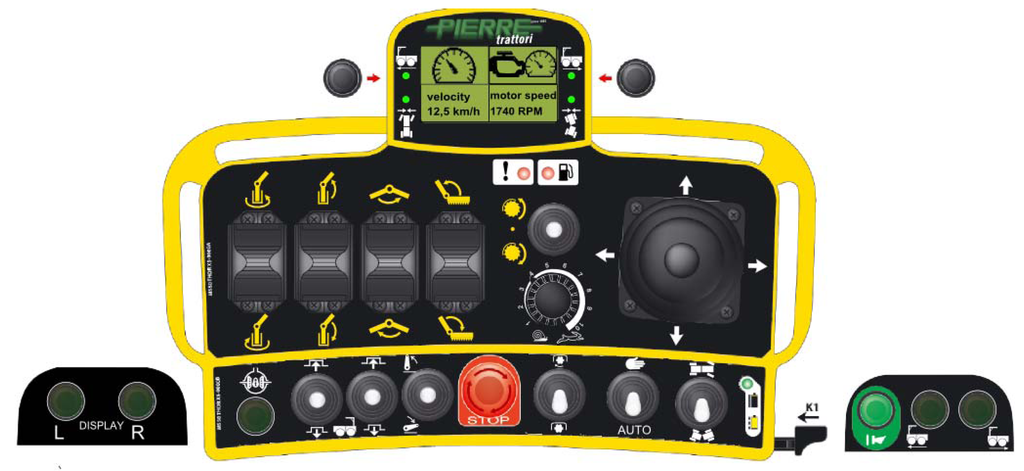
Figure 8.
Remote control transmitting unit.
3.3. Control System Features
The tractor control system developed provides innovative and original functionalities not available today all together in small size tractors. The most relevant ones are: (1) the control of the speed on the base of the engine load (to maintain the engine automatically at a desired, set, power rate); (2) steering assistance to combine front wheels and articulated steering for minimum wheel skid; (3) remote control up to 200 m from the tractor; and (4) fully automatic operation.
The velocity of the tractor depends on the hydraulic oil flow provided by the main pump run by the tractor engine. The operational power, with any implement, is a function of the tractor speed and it tends to zero when the speed goes to zero. In cases when the attached implement, under a heavy load (e.g., mulcher processing compact soil or cutting very thick vegetation), absorbs an amount of power reaching the 93% of the engine maximum capacity, the engine speed lowers to the level at which the hydraulic pump is not able to produce sufficient hydraulic oil flow enough to propel the hydraulic motors continuously. When this situation occurs the tractor starts moving in a flutter way. In severe cases, the engine can stop. The speed control implemented reads the current engine load and adjusts the velocity of the tractor to guarantee smooth and uninterrupted movement. The hydraulic pump for the traction has variable displacement: the control system maintains the speed of the engine constant while the displacements of hydraulic pump and motor are adjusted to work at constant maximum power.
The steering assistance (SA) uses a model of the tractor kinematics and the current tractor configuration known from sensors positioned in the front wheels and in the central articulation. Two steering options are available: automatic steering (automatic combination of front and articulated steering) and manual steering.
3.4. Tractor Applications
Figure 9 shows two applications of the tractor in agriculture in tasks that could not be carried out in the same way without the robotic functions developed. In the case of tractor equipped with orchard platform, Figure 9a, the remote control allows the operator to control the tractor directly from the platform attached to the tractor. Platforms designed to be operated (lifted or lowered) from the cabin of the tractor using hydraulic oil distributors can be safely operated via the remote control using the transmitter from the board of the platform (the remote control system conforms to ISO 13849-1 Pl:e and ISO 62061SIL 3 for the E-STOP safety function and Pl:d category 3 and/or SIL 2 for the steering functions).
Figure 9b shows the use of a side-arm brushcutter operated from remote with no need of a separate control device, using the joysticks already available in the remote control board. With an additional control module in the tractor, working as a gateway between the TECS internal bus and the auxiliary device interface bus, it is possible to command implements equipped with electronic modules using the CAN-BUS ISO 11783 (ISOBUS) agricultural machine protocol (based on the J1939 protocol).
A planner operating up to four tractors, through the autonomous navigation layer, is under implementation. It comprises, for each tractor, also the control of the side-arm brushcutter: (a) navigation of the tractor along specified trajectory; (b) positioning of the brushcutter head along specified trajectory adapting to the geometry of the terrain.

Figure 9.
Example applications of the tractor with TECS: (a) with orchard platform; (b) with side-arm brushcutter.
In the first task the software developed in the ROS framework is responsible for the localization of the tractor and its navigation along the specified trajectory. The localization part of the software will use signals coming from the RTK DGPS system and odometry sensors to localize the tractor in the work coordinate system (a coordinate system tied to the base of the stationary receiver of the RTK DGPS system).
The second task controls the actuators of the arm, Figure 10. The arm is in floating mode (laid on the surface of the terrain) and the center of the wrist of the brush-cutter is moved in a plane orthogonal to the direction of motion of the tractor to follow the desired trajectory.
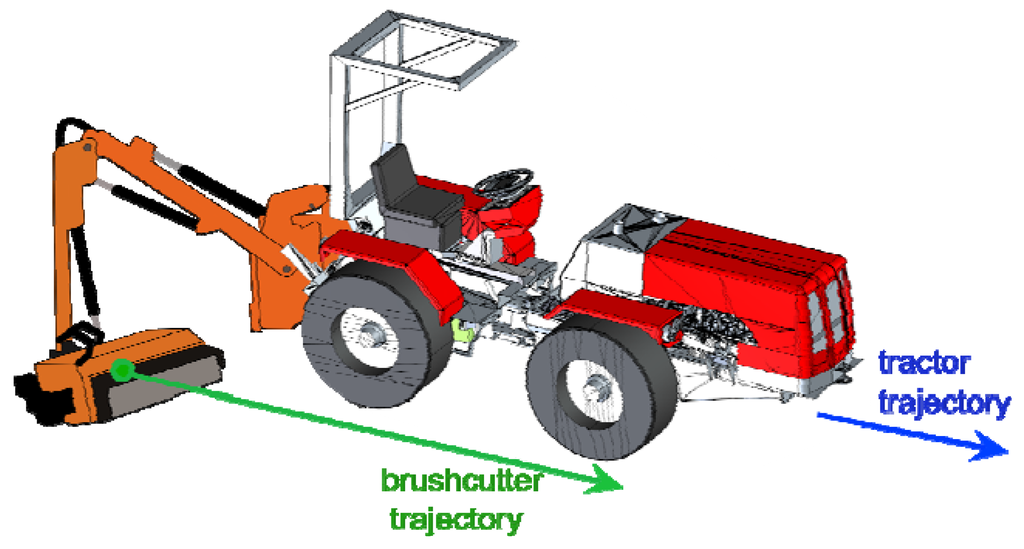
Figure 10.
Autonomous operation mode example.
4. Field Tests
The machine was tested, first, in Italy, to confirm functions and performance. At the end of this domestic campaign, the machine was shipped to Jordan and tested in minefields in real operative conditions and by professional demining personnel. All the tests done in the two campaigns, and reported in the following, focus on specific performance figures of the machine; campaigns aimed at collecting data for statistical assessment of the success rate of the machine, for instance with implements for mine exposure, or the rate of blasted mines during, for instance, vegetation cutting, will be organized in the next future as a part of the program of development of the machine.
4.1. Italy in-Field Pre-Test
The tractor ground pressure measured varies depending on the terrain conditions: from 1,813 kPa on class III soil to 453.25 kPa on class I soil (soil classification according to CEN CWA 15044:2009).
The maximum drawbar pull was measured in different soil conditions. The comparison of the experiment data with the computed figures was satisfactory: average 13,700 N in class III soil with moisture content 93% using first gear, average 6,400 N in class III soil with moisture content 93% using second gear; average 19,900 N in class I soil with moisture content 78% using first gear, average 6,400 N in class I soil with moisture content 78% using second gear.
The tractor demonstrated able to climb until 30° of natural hill ground.
Yaw motion stability showed high in the whole working range 0 to 15 km/h for different classes of terrain with best performance in grounds whose characteristic sinkage number was used to design the tractor.
4.2. Jordan in-Field Test
The tests took place at two different locations: in the safe area in front of the minefield Sabha12 along the border with Syria, near Jabir village (later referred to as Jabir test site) and in the suspected hazardous area (SHA) near to the border with Israel, close to Karama village, in the Jordan Valley (later on referred to as Karama test site). The Jabir test site had no vegetation and class I soil; the Karama test site had vegetation and class I soil.
The test protocol followed the CWA15044:2009 and took place in three subsequent phases: performance test, survivability test and acceptance test. Depending on the vegetation and on the landmines used, LOCOSTRA was equipped with ground processing tool (GPT) (potato digger, Figure 11a) or vegetation cutting tool (mulcher, Figure 11b) or with no tools.

Figure 11.
LOCOSTRA equipped with GPT (a) and with mulcher (b).
The overall results were very satisfactory: as reported by the demining personnel supervising the tests, the tractor accomplished correctly all operations of site preparation for technical survey and demining; the tractor performed well, also, the agricultural operations typical of the recovery of land to agriculture once released as safe from mines. Market agricultural implements available locally were also tested and operated by the tractor using its remote controlled and automatic functions with very good results.
4.3. Performance Tests
The aim of these tests was to evaluate the capability of the GPT on digging buried mines out and relocate them on the surface. 33 dummy AP mines (11 of type M14, 11 of type M35, and 11 of type A10) were laid at different depths between 0 and 15 cm in soft ground, at different distances from each other. Three mm rectangular fibreboards of size 180 cm × 35 cm were placed in the soil to register the penetration profile. The results are summarized in Table 2.

Table 2.
Performance test results.
| Land Mines | Results |
|---|---|
| 11 of A10 mines were laid direct under the surface | 1. All mines removed to the surface. 2. One min was broken by the tines of the GPT. |
| 11 of M35 mines were laid at the depth of 5 cm | 1. 8 mines removed to the surface. 2. 2 mines touched and moved few centimeters of their location but stayed 5 cm under the surface. |
| 11 of M14 mines were laid at depth of 10 cm | 1. No mines were removed to the surface. 2. 6 mines were only touched by tines and remained almost at the same depth. 3. 5 mines were not touched at all. |
| Fibreboards | Results |
| Three 3 mm fiberboards with dimensions of 180 cm × 35 cm were put in the soil to give the penetration profile | All fiberboards were affected by the tines of the GPT at depth varying from 13–16 cm with average of 15 cm. |
4.4. Survivability Tests
Different types of live mines were laid to evaluate the survivability of the blast resistant wheels, the tractor and the GPT against AP mine blasts. LOCOSTRA resisted well, without needing any repair, to four explosions, as described in Figure 12a.
4.5. Acceptance Tests
The planned tests are the following; the main results are collected in Table 3.
- Five live mines (M14) were laid at different depths between 0 and 10 cm in soft ground. Two mines were passed over by the wheels and three ones were processed by the GPT.
- Two live mines (M35) were laid in a safe area and passed over by the wheels. The test was repeated in an active mine field containing mines of type PMN (containing 240 g of TNT explosive).
- Two days of tests using the mulcher on suspected hazardous areas covered by medium and tall vegetation in the Jordan Valley.

Table 3.
Survivability tests results.
| Activities | Results |
|---|---|
| One live M14 (28 g) was laid at depth of 5cm to be activated by the rear wheel | (1). The mine was activated.
(2). No damage reported. |
| One live M14 (28 g) was laid at depth of 5cm to be activated by the front wheel | (1). The mine was not activated. |
| Two live M14 were laid to be processed by the GPT. One of them was lad directly under the surface and one was laid at depth of 10 cm | (1). One mine was removed to the surface.
(2). One mine exploded under the wheel of the GPT. |
| Two live M35 (100 g) were laid, the first one was laid on the surface one meter from the front wheel, the second mine was laid one meter from the rear wheel at 5cm depth. Wheels past over the mines | (1). The first mine was activated, no damage to the wheel was reported.
(2). The second mine was not activated. The mine was removed out by the GPT and it was found pressed down and cracked. |
| Two live PMN (240 g) were laid, the first one was laid on the surface one meter from the front wheel, the second mine was laid one meter from the rear wheel at 5 cm depth. Wheels past over the mines | (1). The first mine was activated, only light damage was caused to the wheel.
(2). The second mine was not activated, it was disposed by another mine. |
The tests with the GPT opened up space for further study and a proposal on the possible application of agricultural tools in demining. Even if the GPT would benefit from further studying, it proved to be a very efficient tool for ground processing and mine removal. In fact, the GPT successfully removed mines down to a depth of 5 cm without exploding them, Figure 12b. When tested with target wooden mines, after adjusting the length of the third-point linkage, it reached the working depth of 15 cm. Damages recorded after the survivability tests were very localized and easy to repair, Figure 12c.
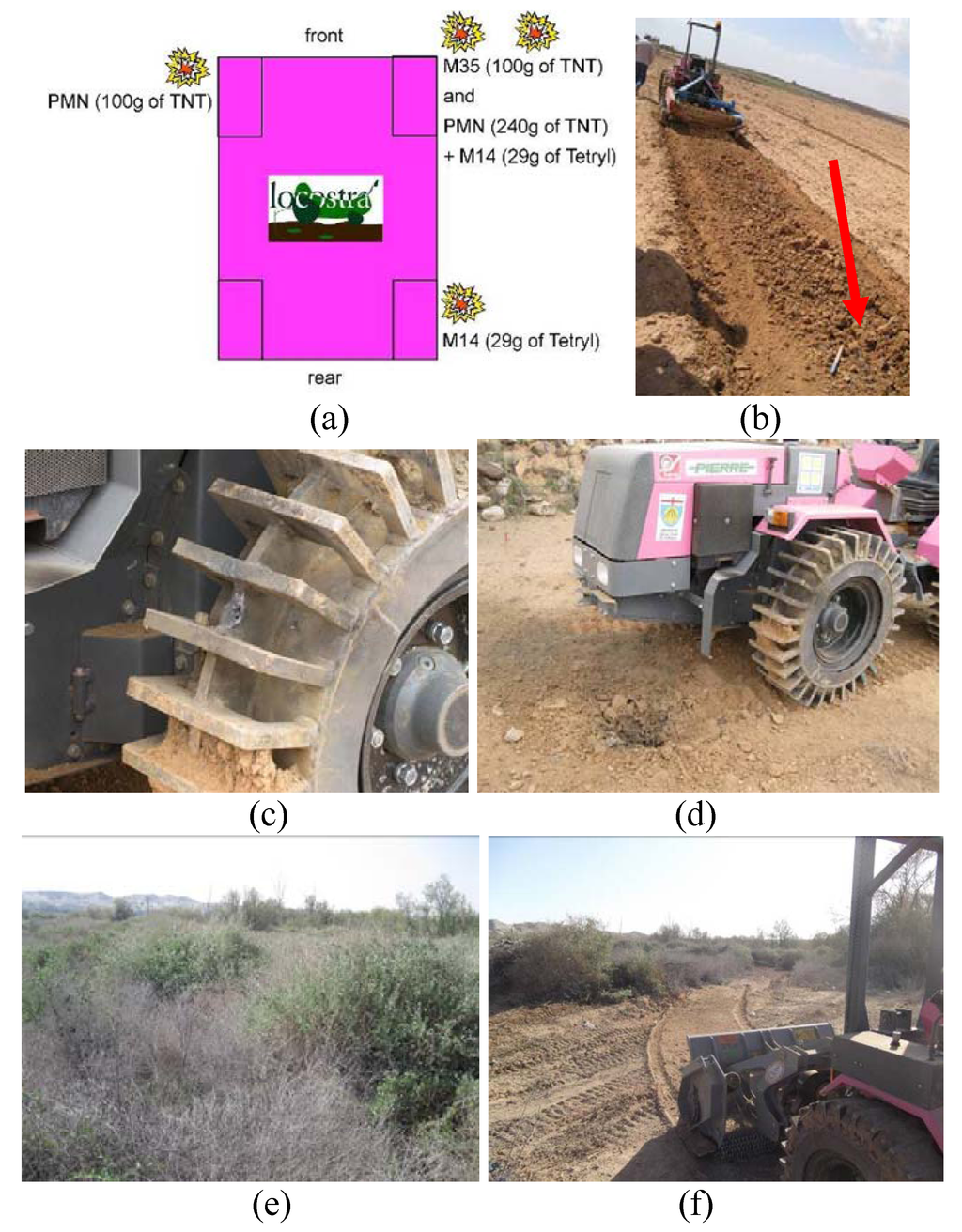
Figure 12.
LOCOSTRA test campaign in Jordan: reference test mine location (a); (b) Explosions occurred under LOCOSTRA, an M14 mine removed and processed by the GPT without explosion (c); the worst damage caused to blast resistant wheels (very light) after a PMN explosion (d); medium vegetation before (e); and after clearance (f).
The combination of LOCOSTRA with the mulcher proved to be ready to be exploited in mine action activities. LOCOSTRA with the mulcher successfully cut low, Figure 12e, medium and tall vegetation up to small trees 15 cm in diameter. Especially during the pre-tests in Italy, where LOCOSTRA equipped with the mulcher was tested in forest-like areas, the high agility and great efficiency of the machine was appreciated. Thanks to the double steering system, the tractor could turn around the bigger trees (that generally do not have to be cut) and cut all the others. Moreover, the mulcher capacity to slightly process the soil was also appreciated, as it can be seen from Figure 12f.
5. Conclusions
This paper presents the first phase of the development of the tractor robotic platform called LOCOSTRA. This machine was designed to accomplish agricultural and demining tasks, a unique case ever. It was built and tested using implements typical of agriculture, with modifications to make them operable by a semi-autonomous robotic tractor, without missing the original agricultural application. The work done to develop the LOCOSTRA machine results in providing solutions valid both for demining and agriculture activities. The features of the machine: light weight, small size, great manoeuvrability, remote and semi-autonomous control, and automated functions; give new quality tools for use as well in agriculture as in demining.
The modular approach adopted in the development process results in a flexible framework, divided into smaller subsystems (Tractor Electronic Control System, Remote Control System, intelligent auxiliary tools, higher level control modules), which can be easily transferred and applied to other agricultural vehicles in order to make them controlled remotely and add them some autonomy.
The use of LOCOSTRA for humanitarian demining is confirmed by the results of the tests performed which also confirm all the initial statements and the expectations of the end-users involved.
The work on the system continues with the development of the navigation and autonomous operation, with the aim to achieve in field autonomy. A peculiarity of the LOCOSTRA system is the high readiness level, already 9, remarkably high for the field of application.
The LOCOSTRA machine has been included within the technologies for technical survey on which the European project TIRAMISU (Toolbox Implementation for Removal of Antipersonnel Mines, Submunitions and UXO) research is based.
Acknowledgments
The Italian Ministry of Economic Development and the Italian Institute for Foreign Trade that co-funded the LOCOSTRA project, coordinated by the University of Genoa, are gratefully acknowledged.
Authors Contributions
Emanuela Elisa Cepolina, prime researcher at Snailaid, developer of the demining application of LOCOSTRA and expert on machine architecture and implements for humanitarian demining, responsible for in-field tests planning. Michał Przybyłko, developer of the automation and control part of LOCOSTRA, developer of the control hardware infrastructure. Giovanni Battista Polentes, manufacturer of the tractor, designer of the machine with focus on the mechanical components, responsible for the preparation and development of the in-field tests. Matteo Zoppi, development coordinator, responsible for the integration, responsible for part of the design of the machine.
Conflicts of Interest
The authors declare no conflict of interest.
References
- Acaccia, G.M.; Michelini, R.C.; Molfino, R.M.; Razzoli, R.P. Mobile Robots in Greenhouse Cultivation: Inspection and Treatment of Plants. In Proceedings of the 1st International Workshop Advanced in Service Robot, Bardolino, Italy, 13–15 March 2003.
- Kondo, N.; Morita, M.; Noguchi, N. Agricultural Robots: Mechanisms and Practice; Trans Pacific Press: Melbourne, Australia, 2011; pp. 1–360. [Google Scholar]
- Yukumoto, O.; Matsuo, Y.; Noguchi, N. Robotization of agricultural vehicles (Part 1). Jpn. Agri. Res. Q. 2000, 34, 99–105. [Google Scholar]
- Yukumoto, O.; Matsuo, Y.; Noguchi, N. Robotization of agricultural vehicles (Part 2). Jpn. Agri. Res. Q. 2000, 34, 107–114. [Google Scholar]
- Matsuo, Y.; Yukumoto, O.; Yamamoto, S.; Noguchi, N.; Hara, Y. Review enhanced adaptability of tilling robot (2nd report)—Execution of various operations by tilling robot. Jpn. Agri. Res. Q. 2013, 47, 153–164. [Google Scholar] [CrossRef]
- Ismail, W.I.W.; Hudzari, R.M.; Saufi, M.K.M.; Fung, L.T. Computer-controlled system for autonomous tractor in agricultural application. J. Food Agri. Environ. 2012, 10, 350–356. [Google Scholar]
- Cepolina, E.E. Power tillers and snails for demining in Sri Lanka. J. Mine Action 2006, 10, 76–79. [Google Scholar]
- Dixon, R. A Concept of Implementing Technology to Encourage Economic Growth in Demining. In Proceedings of the International Workshop on Robotics and Mechanical Assistance in Humanitarian Demining and Similarly Risky Interventions, Brussels, Belgium, 16–18 June 2004.
- Bottomley, R. Returning Life to Field and Forest: Demining by Villagers in Cambodia. Available online: http://www.jmu.edu/cisr/journal/5.1/Focus/Ruth_Bottom/bottom.html (accessed on 10 March 2014).
- Knight, P.; Jenkins, J.O. Adopting and applying eco-design techniques: A practitioners perspective. J. Clean. Prod. 2009, 17, 549–558. [Google Scholar] [CrossRef]
- Cepolina, E.E.; Zoppi, M. Could local agricultural machines make a country “impact free” by 2010? Int. J. ERW Mine Action 2009, 13, 47–52. [Google Scholar]
- Rovira-Más, F. Sensor Architecture and task classification for agricultural vehicles and environments. Sensors 2010, 10, 11226–11247. [Google Scholar] [CrossRef]
- Delhay, S.; Lacroix, V.; Idrissa, M. PARADIS: Focusing on GIS Field Tools for Humanitarian Demining. In Proceedings of the Fifth IARP WS HUDEM, Brussels, Belgium, 16–18 June 2004.
- Horton, D.N.L.; Crolla, D.A. Theoretical analysis of the steering behaviour of articulated frame steer vehicles. Veh. Syst. Dyn. 1986, 15, 211–234. [Google Scholar] [CrossRef]
- Crolla, D.A.; El-razaz, A.S.A. A review of the combined lateral force generation of tires on deformable surfaces. J. Terramechanics 1987, 24, 199–225. [Google Scholar] [CrossRef]
- Gee-Clough, D.; Sommer, M.S. Steering forces on undriven, angled wheels. J. Terramechanics 1981, 18, 25–49. [Google Scholar] [CrossRef]
- Metz, L.D. Dynamics of four-wheel-steer off-highway vehicles. SAE Paper 1993. [Google Scholar] [CrossRef]
- Iida, M.; Fukuta, M.; Tomiyama, H. Measurement and analysis of side slip angle of articulated vehicle. Eng. Agric. Environ. Food 2010, 3, 1–6. [Google Scholar] [CrossRef]
- Azad, N.L.; Khajepour, A.; Mcphee, J. Robust state feedback stabilization of articulated steer vehicles. Veh. Syst. Dyn. 2007, 45, 249–275. [Google Scholar] [CrossRef]
- Bekker, M.G. Off-the-Road Locomotion, Research and Development in Terramechanics; University of Michigan Press: Ann Arbor, MI, USA, 1960. [Google Scholar]
- Cepolina, E.E.; Zoppi, M.; Belotti, V. Locostra: Blast-resistant wheels test. Int. J. ERW Mine Action 2011, 15, 75–81. [Google Scholar]
- Naselli, G.A.; Polentes, G.; Cepolina, E.E.; Zoppi, M. A simple procedure for designing blast resistant wheels. Procedia Eng. 2013, 64, 1543–1551. [Google Scholar] [CrossRef]
- Przybyłko, M.; Cepolina, E.E.; Zoppi, M.; Polentes, G. A Robust, Simple, Low-Cost Autonomy Enhancement Module for Locostra: A Remotely Controlled Demining Machine. In Proceedings of the 9th International Symposium HUDEM 2012, Sibenik, Croatia, 24–26 April 2012.
- Livatino, S.; Muscato, G.; Sessa, S.; Koffel, C.; Arena, C.; Pennisi, A.; Di Mauro, D.; Malkondu, E. Depth-enhanced mobile robot teleguide based on video images. IEEE Robot. Automa. Mag. 2008, 15, 58–67. [Google Scholar]
© 2014 by the authors; licensee MDPI, Basel, Switzerland. This article is an open access article distributed under the terms and conditions of the Creative Commons Attribution license (http://creativecommons.org/licenses/by/3.0/).